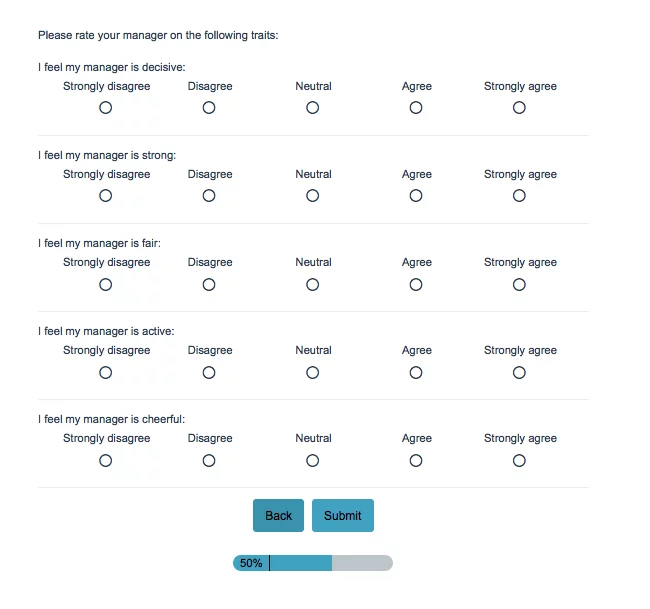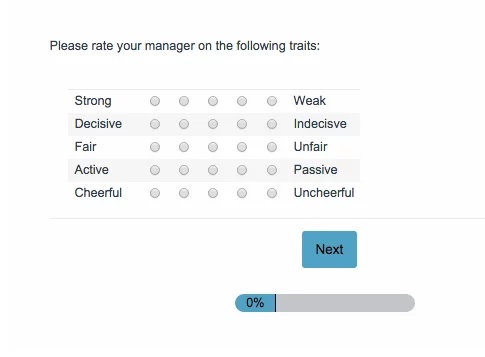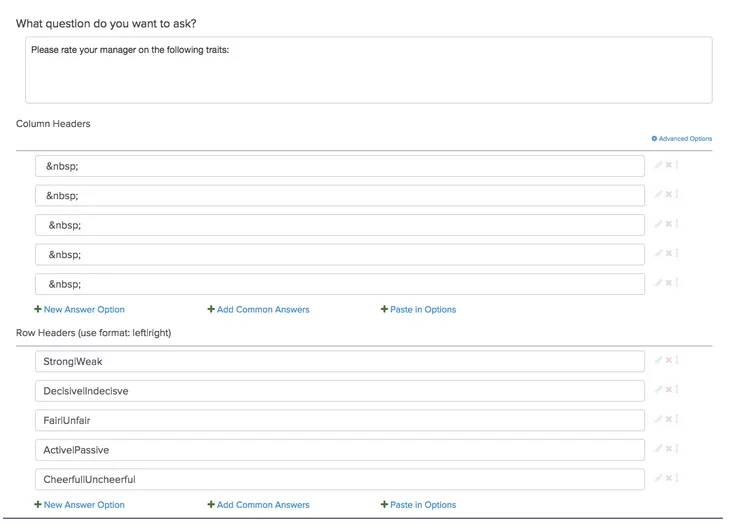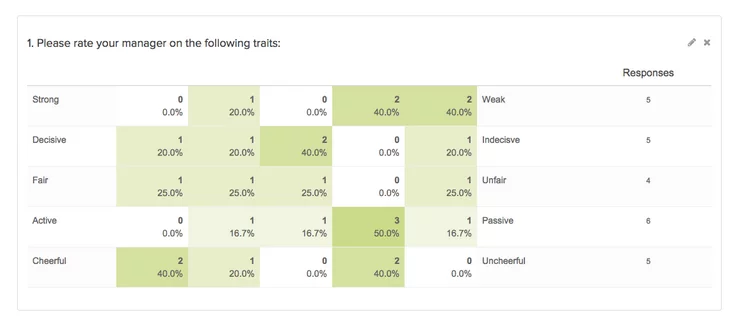Semantic differential questions allow for measuring the attitudes or feelings of your respondents that might not be revealed through traditional survey question types.
It sounds complicated, but setting up a semantic differential question is simple, and offers big payoffs in data confidence.
When to Use Semantic Differential
As an example, let’s say we’re conducting an employee evaluation of their managers. We could use Likert scale questions like these:

Or you could use this:

Which do you think looks easier for the respondent?
When using the Likert scale questions, if you say, “I feel my manager is decisive,” the way you are using “decisive” could influence the survey respondent and give you less than accurate feedback.
You could go the other direction and say, “I feel my manager is indecisive,” but then you would have the same problem.
Semantic Differential to the rescue!
This is a rating scale that can measure respondent attitudes towards ideas, concepts, items, people, and events. (Sometimes referred to as an attitudinal study). Semantic differential questions simply ask where the respondent’s position is on a scale between two bipolar adjectives, such as “Happy-Sad,” “Creamy-Chalky,” or “Bright-Dark.”
A Brief History of Semantic Differential
Semantic Differential questions were developed by C.E. Osgood in 1957 precisely to measure the connotative meaning of cultural objects. The use of semantic differential questions have been seen in various social sciences, market research, and therapy.
Osgood performed research on large collections of semantic differential scales and found that three dimensions of affective meaning were universal across cultures, despite those cultures’ linguistic differences:
- Evaluation: pairs like ‘good-bad.’
- Potency: pairs such as ‘powerful-weak.’
- Activity: includes pairs like ‘active-passive.’
These bipolar types of adjectives can be used to measure a wide variety of subjects, from employees’ perception of managers to consumer’s attitudes about a new product.
Using Semantic Differential in a Survey
When you employ semantic differential questions the data gathered can give you a powerful picture of the respondent’s attitude toward the subject being studied.
Rather than using a generic scale that might range from very satisfied to very dissatisfied, as is commonly found in Likert scale questions, semantic differential questions are posed within the context of evaluating attitudes.
In the example illustration above, the respondent can pick any of the five graduations between the adjectives, and the midpoint can instantly be recognized.
Setting Up the Semantic Differential Question in Alchemer
To deploy this powerful tool in your own surveys, add a question to your survey and select question type. Scroll down to ‘advanced’ and you will find Semantic Differential.

You can then enter your instructions to your respondent under, “What question do you want to ask?”

Then you can set up your column headers. You might use 1-5 as a column header, or if you prefer blank column headers like in my example you can enter this code:
That code is short for non-breaking space; it allows the column headers to remain blank.
In the row headers you can enter the bipolar adjectives that the respondent will see in this format: Strong|Weak.
(The symbol between the adjectives is the pipe symbol. It is usually located above and to the right of the enter key on most keyboards.)
Make sure to save your question, and you’re all set.
Reporting and Statistical Properties
Semantic differential questions in Alchemer report as a table with values and percentages for each option, along with the total number of responses. In my example, I created ten test responses for the managerial review question.
Here is what the summary report would look like:

Our test data generating robots are fairly random. However, when taken by live respondents, trends (or the lack of them) would be readily apparent.
Now that you know what a semantic differential is, you’re ready to conduct a study of your respondent’s attitudes the topic of your choice.
For more information about semantic differential questions in Alchemer, take a look at our documentation.